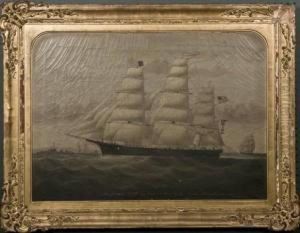William G. Yorke Paintings
William Gay Yorke was a prominent marine artist, renowned for his exquisite ship portraits and maritime scenes in the 19th century. Born in 1817, Yorke's early years and training are somewhat shrouded in mystery, contributing to the enigmatic allure surrounding his artistic journey. Despite the lack of comprehensive records about his formative years, it is evident that Yorke possessed a natural talent and a profound passion for the sea and sailing vessels, which became the central theme of his artistic oeuvre.
Yorke spent most of his life in England and Canada, with significant periods in Liverpool and later in Toronto. His dedication to accurately depicting ships, from their intricate rigging to the texture of their sails against the changing seas, earned him a distinguished reputation among ship owners, captains, and maritime enthusiasts who sought his work for its meticulous detail and authenticity.
Throughout his career, William G. Yorke demonstrated a remarkable ability to capture the essence of maritime life, making his paintings not only beautiful works of art but also valuable historical documents. His works often featured a variety of vessels, including majestic clippers, sturdy brigs, and elegant schooners, each rendered with precision and care. Yorke's paintings are characterized by their detailed accuracy, vibrant composition, and the ability to convey the mood of the sea, from tranquil waters to tumultuous storms.
Despite his success, Yorke maintained a low profile, focusing on his craft rather than seeking fame. He passed away in 1892, leaving behind a legacy of art that continues to captivate and inspire. Today, William G. Yorke's paintings are highly sought after by collectors and are held in prestigious collections around the world, celebrated for their contribution to maritime history and art. His work not only provides a window into the maritime past but also stands as a testament to his enduring talent and his profound connection to the sea.

